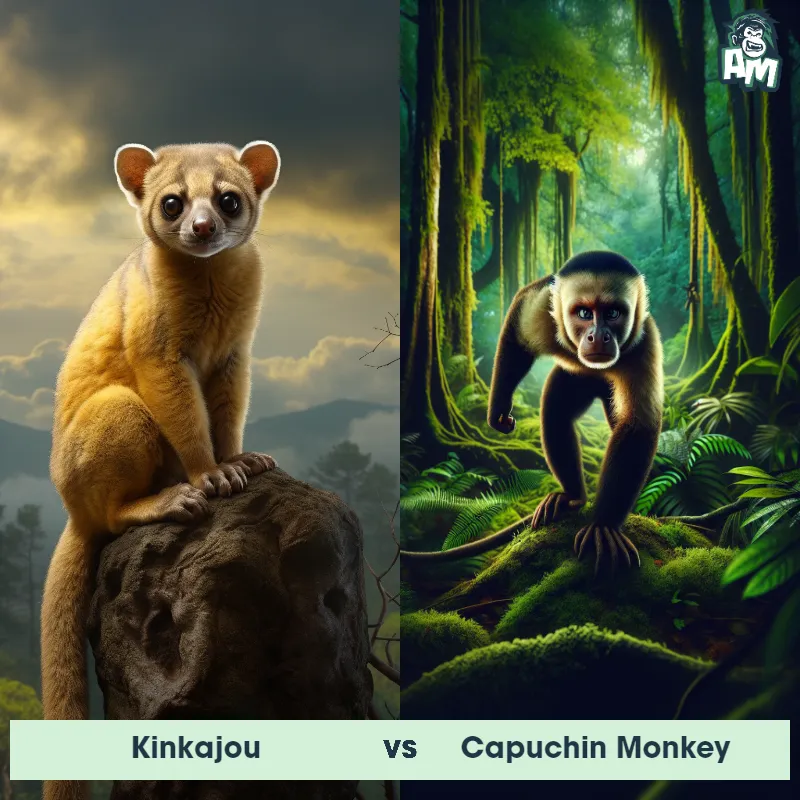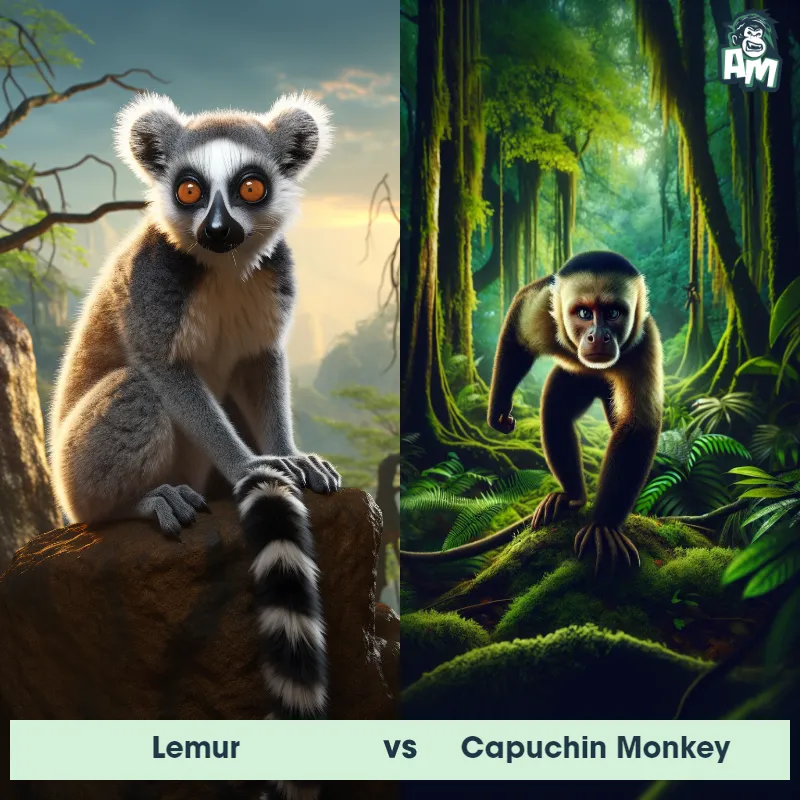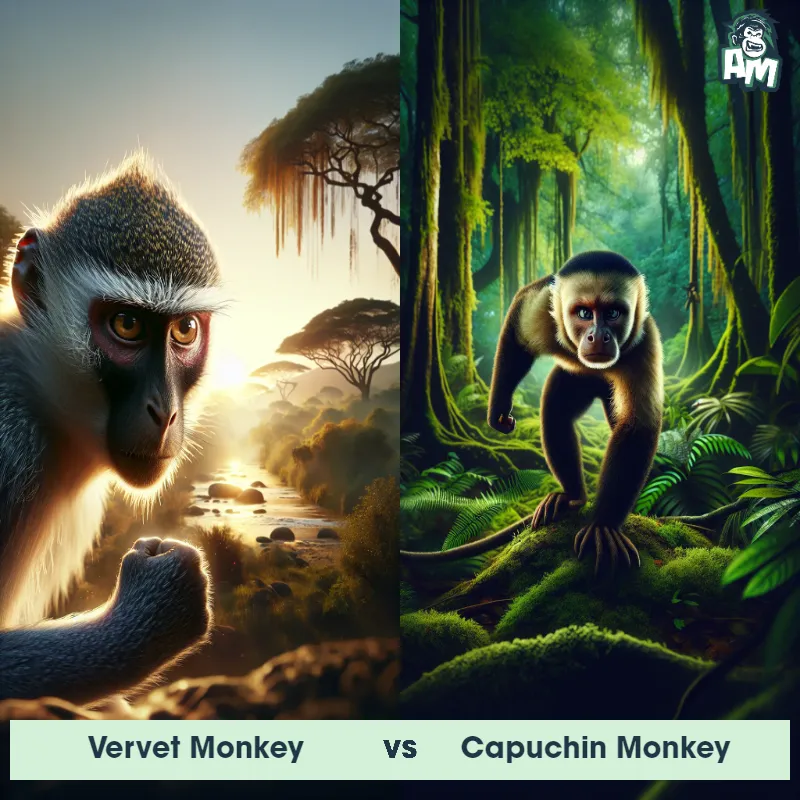The Capuchin Monkey
The Capuchin Monkey, known for its agile and intelligent nature, is a small primate native to Central and South America. It is characterized by its petite body, long prehensile tail, and distinct facial features. Capuchin Monkeys possess a unique crown of hair on their heads, resembling a monk's "cowl," which gives them their name. They have dexterous hands and sharp claws, enabling them to grasp objects and climb trees with ease. These highly social creatures often form close-knit groups and communicate using a wide variety of vocalizations and body gestures.

| Capuchin Monkey | |
|---|---|
| Size | 12 to 22 inches (30 to 56 cm) |
| Weight | 3.5 to 9 pounds (1.5 to 4 kg) |
| Speed | 34 mph (55 km/h) |
| Key Strength | Agility and flexibility |
| Biggest Weakness | Lack of physical power |
| Scientific Name | Cebus capucinus |
| Family | Cebidae |
| Habitat | Tropical rainforests, dry forests, and mangrove swamps |
| Geography | Central and South America |
| Diet | Omnivorous - primarily fruits, nuts, seeds, insects, spiders, and small vertebrates |
| Lifespan | 20 years - 30 years |

The Capuchin Monkey
The Capuchin Monkey, known for its agile and intelligent nature, is a small primate native to Central and South America. It is characterized by its petite body, long prehensile tail, and distinct facial features. Capuchin Monkeys possess a unique crown of hair on their heads, resembling a monk's "cowl," which gives them their name. They have dexterous hands and sharp claws, enabling them to grasp objects and climb trees with ease. These highly social creatures often form close-knit groups and communicate using a wide variety of vocalizations and body gestures.
Fun Fact: Capuchin Monkeys have been observed using stones as tools to crack open nuts and shellfish. They exhibit remarkable problem-solving abilities and can carefully select and use objects to accomplish specific tasks.
| Capuchin Monkey | |
|---|---|
| Size | 12 to 22 inches (30 to 56 cm) |
| Weight | 3.5 to 9 pounds (1.5 to 4 kg) |
| Speed | 34 mph (55 km/h) |
| Key Strength | Agility and flexibility |
| Biggest Weakness | Lack of physical power |
| Scientific Name | Cebus capucinus |
| Family | Cebidae |
| Habitat | Tropical rainforests, dry forests, and mangrove swamps |
| Geography | Central and South America |
| Diet | Omnivorous - primarily fruits, nuts, seeds, insects, spiders, and small vertebrates |
| Lifespan | 20 years - 30 years |
Capuchin Monkey Matchups
We use AI to simulate matchups between the Capuchin Monkey and other animals. Our simulation considers size, strength, and natural predatory behaviors to determine the most likely outcome.
Capuchin Monkey: Diet, Predators, Aggression, and Defensive Behaviors
What do Capuchin Monkeys eat?
Capuchin monkeys are omnivores and have a varied diet. They primarily feed on fruits, nuts, seeds, flowers, and insects. They also consume small animals like birds, bird eggs, and small mammals. Additionally, they are known to eat leaves, flowers, and even small reptiles.
Do Capuchin Monkeys have any predators?
Capuchin Monkeys do have predators in the wild. Some of their main predators include large birds of prey such as eagles and hawks, as well as big cats like jaguars and ocelots. Humans also pose a threat to Capuchin Monkeys due to habitat destruction, hunting, and the illegal pet trade.
Are Capuchin Monkeys aggressive?
Capuchin Monkeys can exhibit aggressive behavior, especially when feeling threatened or territorial. They may show aggression towards other monkeys or humans if they perceive them as a threat. However, aggression is not their default behavior and they are generally peaceful animals when left undisturbed.
Do Capuchin Monkeys fight?
Capuchin Monkeys are known to engage in fights within their own social groups, particularly for dominance and hierarchy. These fights can involve physical aggression such as biting, scratching, and vocalizations. However, fights are typically resolved quickly, and dominant individuals establish their authority without causing serious harm.
How do Capuchin Monkeys defend themselves?
Capuchin Monkeys have several defense mechanisms to protect themselves from predators and threats. They may vocalize loudly to signal danger to their group, flee to safety by climbing trees, or hide in dense vegetation. Additionally, they can use their sharp teeth and agility to fend off attackers or predators if necessary.
What is the biggest weakness of Capuchin Monkeys in a fight?
Despite their agility and sharp teeth, one of the biggest weaknesses of Capuchin Monkeys in a fight is their relatively small size compared to some of their predators or larger competitors. This makes them vulnerable to being overpowered by stronger animals, so they often rely on their speed and agility to evade conflicts whenever possible.
Fun Fact: Capuchin Monkeys have unique grooming behaviors. They often urinate on their hands and rub the urine on different body parts as a form of scent marking and hygiene maintenance. This peculiar habit helps them establish social bonds within their group and maintain a well-groomed appearance.
Fun Fact: Capuchin Monkeys have been known to exhibit altruistic behaviors, displaying empathy and assisting others in their group. They have been observed sharing food, defending fellow group members from predators, and even aiding injured individuals. This cooperative nature highlights their complex social structure and emotional intelligence.















